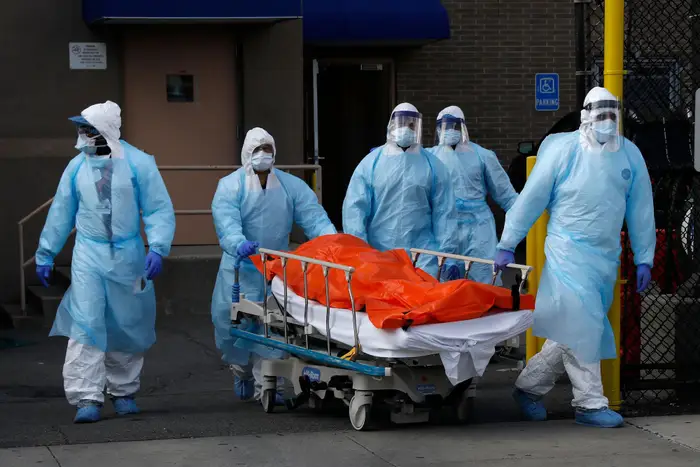How the Pandemic Increased US Deaths: Visualized in Eight Charts
The COVID-19 pandemic brought unprecedented challenges to public health worldwide, and the United States was no exception. As the virus spread across the nation, it significantly impacted various aspects of daily life, including causing a marked rise in the number of deaths. Over the course of the pandemic, more than a million lives were lost in the U.S. alone, making it a pivotal period in the country’s history. This article delves into how the pandemic influenced mortality rates in the U.S., with a special focus on eight charts that offer a visual understanding of the key trends, shifts, and data related to the surge in deaths during and after the pandemic.
Chart 1: COVID-19 Deaths in the U.S. Over Time
The most direct impact of the pandemic on mortality was, of course, the deaths caused by COVID-19 itself. From the first known cases in early 2020 to the waves of infections that followed, the pandemic led to significant loss of life. The chart below tracks the number of confirmed COVID-19 deaths in the U.S. over time, showing a clear exponential increase, particularly during the winter of 2020 and early 2021, when the country faced multiple surges due to more contagious variants of the virus.
The initial wave of COVID-19 in the spring of 2020 led to a sharp rise in deaths, followed by a somewhat stable but still high number of daily fatalities. The most significant surge came during the winter months, when the virus reached new peaks of infection. While the introduction of vaccines in late 2020 and 2021 helped slow down the rate of infections and deaths, there were still waves of increased mortality throughout the pandemic. By 2022, COVID-19 deaths continued to be a substantial contributor to total deaths in the U.S.
Chart 2: Total U.S. Deaths by Year (Pre- and Post-Pandemic)
In addition to the deaths directly attributed to COVID-19, the pandemic also had a broader impact on overall mortality in the U.S. This chart illustrates the total number of deaths in the U.S. for the years before, during, and after the pandemic. It is evident from the chart that total deaths spiked significantly starting in 2020, well beyond what was typical for the preceding years.
This increase in deaths, which reached a level far exceeding the yearly average, was not solely due to COVID-19. Other factors, including delayed medical treatments, worsening mental health, economic stress, and increased fatalities from other causes like heart disease and diabetes, also contributed to this surge. The chart helps us understand how the pandemic exacerbated existing health issues and created new risks, particularly for vulnerable populations.
Chart 3: Excess Deaths in the U.S.
Excess deaths are defined as the number of deaths that occurred above what would have been expected based on historical trends. This chart visualizes the concept of excess deaths, which includes both deaths directly caused by COVID-19 and those indirectly influenced by the pandemic. The surge in excess deaths clearly highlights how the pandemic impacted mortality in ways that went beyond the virus itself.
Excess deaths are crucial because they reflect the full toll of the pandemic, including those who died due to factors such as postponed medical treatments, disruptions to health services, and the long-term health consequences of the virus. For example, people with chronic conditions might have died from lack of access to regular care, and mental health issues, such as depression and anxiety, surged during the pandemic, contributing to higher rates of suicide and substance abuse-related deaths.
Chart 4: COVID-19 Deaths and Racial Disparities
One of the most striking aspects of the COVID-19 pandemic was the racial disparities in death rates. Black, Indigenous, and People of Color (BIPOC) communities experienced higher rates of infection and death compared to white populations. This chart breaks down the death rates by racial and ethnic groups, revealing significant disparities in how different populations were affected by the pandemic.
Several factors contributed to these disparities, including differences in access to healthcare, underlying health conditions, employment in high-risk jobs, and social determinants of health such as housing and income inequality. Additionally, systemic racism and historical mistrust of the healthcare system played a role in shaping the outcomes of the pandemic for these communities.
Chart 5: Age-Group Breakdown of COVID-19 Deaths
While COVID-19 had a significant impact across all age groups, it disproportionately affected older adults. This chart presents the breakdown of COVID-19 deaths by age group, showing that the elderly, particularly those aged 65 and older, were at much higher risk of severe outcomes and death.
The data also reveals that while younger populations were generally less likely to experience fatal outcomes from the virus, they were still significantly impacted in terms of hospitalization rates and long-term health issues. The pandemic revealed critical gaps in age-based health strategies and highlighted the need for focused protection for the elderly and immunocompromised individuals.
Chart 6: Impact of COVID-19 on Mental Health and Suicide Rates
The pandemic had a profound impact on mental health, with a surge in anxiety, depression, and other mental health disorders across the population. The chart below tracks the rise in suicide rates and mental health-related fatalities during the pandemic. As people experienced social isolation, job loss, and fears about the virus, the toll on mental well-being became evident.
Mental health crises were particularly acute among certain groups, including frontline healthcare workers, who faced burnout and trauma from caring for COVID-19 patients, and young people, who were isolated from their peers and educational environments. The increase in mental health-related deaths underscores the secondary effects of the pandemic on public health and the need for improved mental health resources in times of crisis.
Chart 7: Deaths by Cause of Death (Pre-Pandemic vs. Pandemic)
This chart compares the leading causes of death in the U.S. before and during the pandemic. While COVID-19 emerged as one of the leading causes of death, other conditions, such as heart disease, cancer, and diabetes, remained prevalent throughout the pandemic. However, the pandemic led to significant changes in the number of deaths from various causes.
For instance, cardiovascular disease deaths spiked during the pandemic due to factors like delayed medical care, stress, and the direct effects of COVID-19 on the heart. Similarly, cancer deaths were affected by delays in screenings and treatments, resulting in later-stage diagnoses and poorer outcomes. This chart shows how the pandemic indirectly contributed to an increase in deaths from chronic conditions by disrupting normal healthcare delivery and causing patients to avoid medical attention.
Chart 8: State-by-State Variation in COVID-19 Deaths
Finally, the pandemic did not impact all parts of the U.S. equally. This chart visualizes the variation in COVID-19 deaths across different states, highlighting areas that were hit harder and those that experienced more limited impacts. States with larger populations or higher levels of pre-existing health disparities tended to experience higher mortality rates.
For example, states in the southern U.S., such as Texas and Florida, saw significant surges in cases and deaths, especially during the Delta and Omicron waves. Meanwhile, some states in the northeast, like New York and Massachusetts, implemented stricter public health measures earlier on, which helped mitigate some of the more severe effects of the pandemic.
The pandemic undeniably reshaped the landscape of mortality in the United States, with both direct and indirect effects on the health of the nation. The eight charts presented here provide a comprehensive overview of how COVID-19 increased deaths in the U.S. while also underscoring the various ways in which the pandemic altered public health in both immediate and long-term ways. From the direct impact of the virus to the strain on mental health and the indirect effects on chronic diseases, the pandemic has left a profound and lasting mark on U.S. mortality trends.
Understanding these patterns is critical for future public health efforts, as it not only helps policymakers address current needs but also guides them in preparing for future pandemics and health crises. Moving forward, it is essential that health systems are strengthened to address both the direct effects of infectious diseases and the broader, long-term impacts on population health, mental well-being, and access to care. As the U.S. continues to navigate the aftermath of the COVID-19 pandemic, the lessons learned from this time will help shape the future of public health in the nation.























